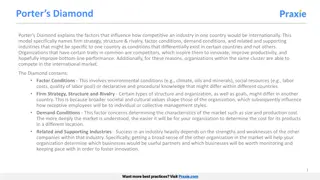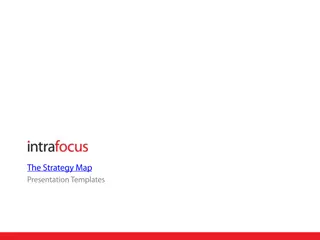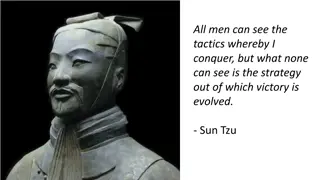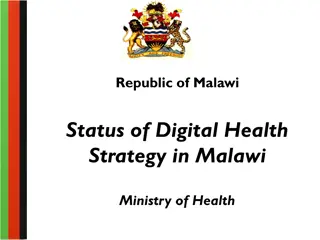Operations Strategy and Competitiveness: Key Concepts and Strategies
Exploring the importance of operations strategy in achieving competitiveness, this content delves into developing business strategies, identifying core competencies, and setting operational priorities. It emphasizes aligning operational activities with business objectives to gain a competitive edge in the marketplace.
Download Presentation

Please find below an Image/Link to download the presentation.
The content on the website is provided AS IS for your information and personal use only. It may not be sold, licensed, or shared on other websites without obtaining consent from the author. Download presentation by click this link. If you encounter any issues during the download, it is possible that the publisher has removed the file from their server.
E N D
Presentation Transcript
Chapter 2 Operations Strategy and Competitiveness Yabibal A.
The Role of Operations Strategy Provide a plan that makes best use of resources which; Specifies the policies and plans for using organizational resources Supports Business Strategy as shown on next slide Yabibal A.
Business/Functional Strategy Yabibal A.
Importance of Operations Strategy Operations strategy ensures all tasks performed are the right tasks Essential differences between operational efficiency and strategy: Operational efficiency is performing tasks well, even better than competitors Strategy is a plan for competing in the marketplace Yabibal A.
To Develop a Business Strategy Consider these factors in strategic decisions: What business is the company in (mission) Analyze and understand the market (environmental scanning) Identify the company strengths (core competencies) Yabibal A.
Three Inputs to a Business Strategy Yabibal A.
Key Examples Mission: Dell Computer- to be the most successful computer company in the world Environmental Scanning: political trends, social trends, economic trends, market place trends, global trends Core Competencies: strength of workers, modern facilities, market understanding, best technologies, financial know-how, logistics Yabibal A.
Developing an Operations Strategy Operations Strategy: a plan for the design and management of operations functions is developed after the business strategy focuses on specific capabilities which give it a competitive edge competitive priorities Yabibal A.
Developing operation strategies and competitive dimensions Operational Strategies
Competitive dimensions of operations Cost: make it cheap Quality: make it good Speed of delivery: make it fast Reliability: provide it when promised Coping with change in demand: change its volume Flexibility and new product development: change it Other product-specific criteria: support it By Yabibal A.
Competitive Priorities- The Edge Four Key Operations Questions: Will you compete on Cost? Quality? Time? Flexibility? All of the above? Some? Tradeoffs? Yabibal A.
Competing on Cost Offering product at a low price relative to competition Typically high volume products Often limit product range & offer little customization May invest in automation to reduce unit costs Can use lower skill labor Probably uses product focused layouts Low cost does not mean always low quality Yabibal A.
Competing on Quality Quality is often subjective Quality is defined differently depending on who is defining it Two major quality dimensions include High performance design: Superior features, high durability, & excellent customer service Product & service consistency: Meets design specifications Close tolerances Error free delivery Quality needs to address Product design quality product/service meets requirements Process quality error free products Yabibal A.
Competing on Time Time/speed one of most important competition priorities First that can deliver often wins the race Time related issues involve Rapid delivery: Focused on shorter time between order placement and delivery On-time delivery: Deliver product exactly when needed every time Yabibal A.
Competing on Flexibility Company environment changes rapidly Company must accommodate change by being flexible Product flexibility: Easily switch production from one item to another Easily customize product/service to meet specific requirements of a customer Volume flexibility: Ability to ramp production up and down to match market demands Yabibal A.
The Need for Trade-offs Decisions must emphasize priorities that support business strategy Decisions often required trade offs Decisions must focus on order qualifiers and order winners Which priorities are Order Qualifiers ? Must have excellent quality since everyone expects it Which priorities are Order Winners ? Dell competes on all four priorities Southwest Airlines competes on cost McDonald s competes on consistency FedEx competes on speed Yabibal A.
Strategic Role of Technology Technology should support competitive priorities Three Applications: product technology, process technology, and information technology Products - Teflon, CD s, fiber optic cable Processes flexible automation, CAM, Robots Information Technology POS, EDI, ERP, B2B Yabibal A.
Technology for Competitive Advantage Technology has positive and negative potentials Positive Improve processes Maintain up-to-date standards Obtain competitive advantage Negative Costly Risks such as overstating benefits Yabibal A.
Technology for Competitive Advantage Technology should: Support competitive priorities Can require change to strategic plans Can require change to operations strategy Technology is an important strategic decision Yabibal A.
Thank you! Questions? Yabibal A.

























